with的复合结构67728
- 格式:doc
- 大小:413.50 KB
- 文档页数:4
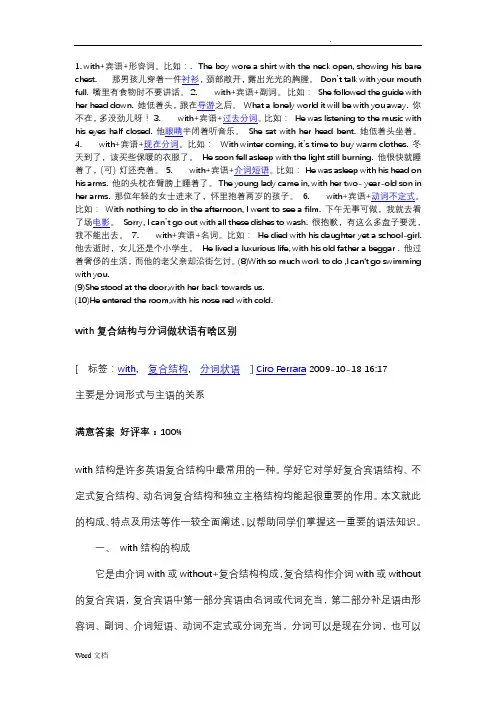
1.with+宾语+形容词。
比如:. The boy wore a shirt with the neck open, showing his bare chest. 那男孩儿穿着一件衬衫,颈部敞开,露出光光的胸膛。
Don’t talk with your mouth full. 嘴里有食物时不要讲话。
2.with+宾语+副词。
比如:She followed the guide with her head down. 她低着头,跟在导游之后。
What a lonely world it will be with you away. 你不在,多没劲儿呀!3.with+宾语+过去分词。
比如:He was listening to the music with his eyes half closed. 他眼睛半闭着听音乐。
She sat with her head bent. 她低着头坐着。
4.with+宾语+现在分词。
比如:With winter coming, it’s time to buy warm clothes. 冬天到了,该买些保暖的衣服了。
He soon fell asleep with the light still burning. 他很快就睡着了,(可)灯还亮着。
5.with+宾语+介词短语。
比如:He was asleep with his head on his arms. 他的头枕在臂膀上睡着了。
The young lady came in, with her two- year-old son in her arms. 那位年轻的女士进来了,怀里抱着两岁的孩子。
6.with+宾语+动词不定式。
比如:With nothing to do in the afternoon, I went to see a film. 下午无事可做,我就去看了场电影。
Sorry, I can’t go out with all these dishes to wash. 很抱歉,有这么多盘子要洗,我不能出去。

With复合结构基本结构:•with/without+宾语+宾语补足语,构成with复合结构。
•宾语可以是名词或者代词。
•宾语补足语可以是现在分词、过去分词、动词不定式、形容词、副词、介词短语、名词。
用途:•在句子中通常做状语,表示原因、时间、条件、伴随、方式等。
•还可以在句子中做定语•Examples:•Jack soon fell asleep with the light still burning.•There was a letter for Lanny with a Swiss stamp on it.•It was a vast stretch of couty with cities in the distance.•With John away, we've got more room.•With the boy leading the way,we will find the house easily tomorrow.•She came into the room, with her nose red because of cold.•With my home work finished,I went fishing with my father.•Do you know the woman with a baby in her arms.•There were rows of houses with trees in front of them.•exercise:1. The girl sat there silent and still with her eyes___on the wall.A: fixing B:fixedC:to be fixing D: to be fixed2.They pretended to be working hard all night with their lights____A: burn B:burntC: burning D:to burn3.I couldn't do my homework with all that noise___A: going on B:goes onC: went on D:to go on4. I live in the house with its door ___ to the south.A: facing B: facesC:faced D:being faced5. John received am invitation to dinner, and with his homework__, he gladly accepted it.A:finished B: finishingC:having finished D: was finished 6.With nothing ___ to burn, the fire became weak and finally died out.A:leaving B:leftC:leave D: to leave。


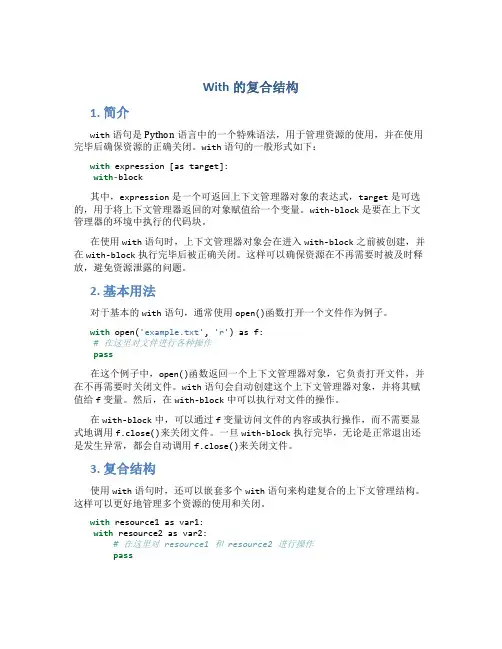
With的复合结构1. 简介with语句是Python语言中的一个特殊语法,用于管理资源的使用,并在使用完毕后确保资源的正确关闭。
with语句的一般形式如下:with expression [as target]:with-block其中,expression是一个可返回上下文管理器对象的表达式,target是可选的,用于将上下文管理器返回的对象赋值给一个变量。
with-block是要在上下文管理器的环境中执行的代码块。
在使用with语句时,上下文管理器对象会在进入with-block之前被创建,并在with-block执行完毕后被正确关闭。
这样可以确保资源在不再需要时被及时释放,避免资源泄露的问题。
2. 基本用法对于基本的with语句,通常使用open()函数打开一个文件作为例子。
with open('example.txt', 'r') as f:# 在这里对文件进行各种操作pass在这个例子中,open()函数返回一个上下文管理器对象,它负责打开文件,并在不再需要时关闭文件。
with语句会自动创建这个上下文管理器对象,并将其赋值给f变量。
然后,在with-block中可以执行对文件的操作。
在with-block中,可以通过f变量访问文件的内容或执行操作,而不需要显式地调用f.close()来关闭文件。
一旦with-block执行完毕,无论是正常退出还是发生异常,都会自动调用f.close()来关闭文件。
3. 复合结构使用with语句时,还可以嵌套多个with语句来构建复合的上下文管理结构。
这样可以更好地管理多个资源的使用和关闭。
with resource1 as var1:with resource2 as var2:# 在这里对 resource1 和 resource2 进行操作pass在这个例子中,resource1和resource2分别表示两个不同的资源。


with的七种复合结构复合结构“with+宾语+宾语补⾜语”是⼀个很有⽤的结构,它在句中主要⽤作状语,表⽰伴随、原因、时间、条件、⽅式等;其中的宾语补⾜语可以是名词、形容词、副词、现在分词、过去分词、不定式、介词短语等。
with的复合结构(1)with+宾语+形容词He often sleeps with the windows open. 他常开着窗睡觉。
Don’t speak with your mouth full. 不要满嘴巴⾷物说话。
(2)with+宾语+副词He stood before his teacher with his head down. 他低着头站在⽼师⾯前。
He was lying on the bed with all his clothes on. 他和⾐躺在床上。
(3)with+宾语+介词短语She said good-bye with tears in her eyes. 她含着眼泪说了声再见。
The man was asleep with his head on his arms. 这个⼈头枕着胳膊睡着了。
(4)with+宾语+现在分词He fell asleep with the lamp burning. 他没熄灯就睡着了。
Iwon’t be able to go on holiday with my mother being ill. 因为妈妈有病,我⽆法去度假。
(5)with+宾语+过去分词He sat there with his eyes closed. 他闭⽬坐在那⼉。
All the afternoon he worked with the door locked. 整个下午他都锁着门在房⾥⼯作。
(6)with+宾语+动词不定式Ican’t go out with all these clothes to wash. 要洗这些⾐服,我⽆法出去了。
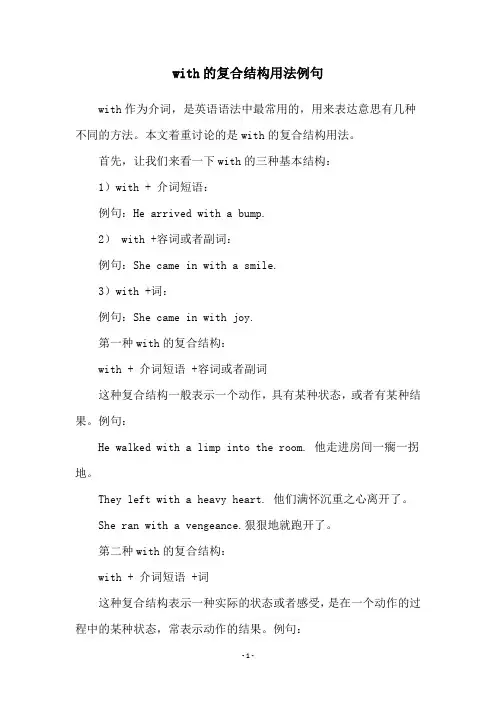
with的复合结构用法例句with作为介词,是英语语法中最常用的,用来表达意思有几种不同的方法。
本文着重讨论的是with的复合结构用法。
首先,让我们来看一下with的三种基本结构:1)with + 介词短语:例句:He arrived with a bump.2) with +容词或者副词:例句:She came in with a smile.3)with +词:例句:She came in with joy.第一种with的复合结构:with + 介词短语 +容词或者副词这种复合结构一般表示一个动作,具有某种状态,或者有某种结果。
例句:He walked with a limp into the room. 他走进房间一瘸一拐地。
They left with a heavy heart. 他们满怀沉重之心离开了。
She ran with a vengeance.狠狠地就跑开了。
第二种with的复合结构:with + 介词短语 +词这种复合结构表示一种实际的状态或者感受,是在一个动作的过程中的某种状态,常表示动作的结果。
例句:She hugged him with love.用爱拥抱了他。
The movie ended with sadness.影以悲伤结束。
He took his leave with regret. 他带着懊悔离去。
第三种with的复合结构:with +词 + 介词短语这种复合结构表示一种特定的情况或状况。
例句:His house was filled with decorations. 他的房子里满是装饰品。
The room was filled with smoke.间里充满烟雾。
The sky is filled with stars.空里满是星星。
以上是with的三种复合结构用法,它们都有丰富多彩的表达方式,在英语中经常用来表达某种额外的信息,有时候这些信息对我们的理解很重要。
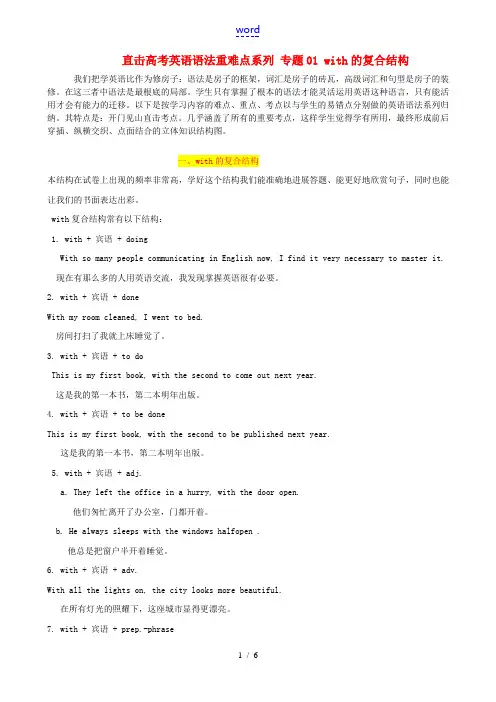
直击高考英语语法重难点系列专题01 with的复合结构我们把学英语比作为修房子:语法是房子的框架,词汇是房子的砖瓦,高级词汇和句型是房子的装修。
在这三者中语法是最根底的局部。
学生只有掌握了根本的语法才能灵活运用英语这种语言,只有能活用才会有能力的迁移。
以下是按学习内容的难点、重点、考点以与学生的易错点分别做的英语语法系列归纳。
其特点是:开门见山直击考点。
几乎涵盖了所有的重要考点,这样学生觉得学有所用,最终形成前后穿插、纵横交织、点面结合的立体知识结构图。
一、with的复合结构本结构在试卷上出现的频率非常高,学好这个结构我们能准确地进展答题、能更好地欣赏句子,同时也能让我们的书面表达出彩。
with复合结构常有以下结构:1. with + 宾语 + doingWith so many people communicating in English now, I find it very necessary to master it.现在有那么多的人用英语交流,我发现掌握英语很有必要。
2. with + 宾语 + doneWith my room cleaned, I went to bed.房间打扫了我就上床睡觉了。
3. with + 宾语 + to doThis is my first book, with the second to come out next year.这是我的第一本书,第二本明年出版。
4. with + 宾语 + to be doneThis is my first book, with the second to be published next year.这是我的第一本书,第二本明年出版。
5. with + 宾语 + adj.a. They left the office in a hurry, with the door open.他们匆忙离开了办公室,门都开着。
b. He always sleeps with the windows halfopen .他总是把窗户半开着睡觉。
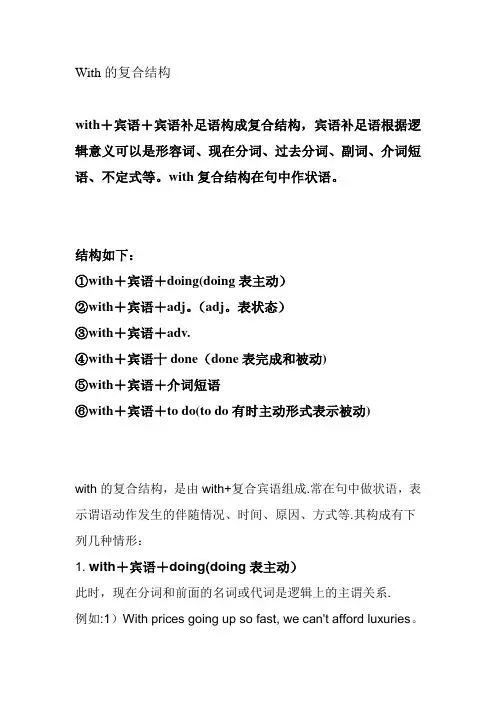
With的复合结构with+宾语+宾语补足语构成复合结构,宾语补足语根据逻辑意义可以是形容词、现在分词、过去分词、副词、介词短语、不定式等。
with复合结构在句中作状语。
结构如下:①with+宾语+doing(doing表主动)②with+宾语+adj。
(adj。
表状态)③with+宾语+adv.④with+宾语十done(done表完成和被动)⑤with+宾语+介词短语⑥with+宾语+to do(to do有时主动形式表示被动)with的复合结构,是由with+复合宾语组成.常在句中做状语,表示谓语动作发生的伴随情况、时间、原因、方式等.其构成有下列几种情形:1. with+宾语+doing(doing表主动)此时,现在分词和前面的名词或代词是逻辑上的主谓关系.例如:1)With prices going up so fast, we can't afford luxuries。
由于物价上涨很快,我们买不起高档商品。
(原因状语)2)With the crowds cheering, they drove to the palace.在人群的欢呼声中,他们驱车来到皇宫。
(伴随情况)2。
with+宾语十done(done表完成和被动)此时,过去分词和前面的名词或代词是逻辑上的动宾关系。
例如:1)I sat in my room for a few minutes with my eyes fixed on the ceiling。
我在房间坐了一会儿,眼睛盯着天花板。
(伴随情况)2)She had to walk home with her bike stolen。
自行车被偷,她只好步行回家。
(原因状语)3。
with+宾语+adj或者adv。
(表状态)例如:1)I like to sleep with the windows open。
我喜欢把窗户开着睡觉。
(伴随情况)2)With the weather so cold and wet,we can’t go out for picnic today。
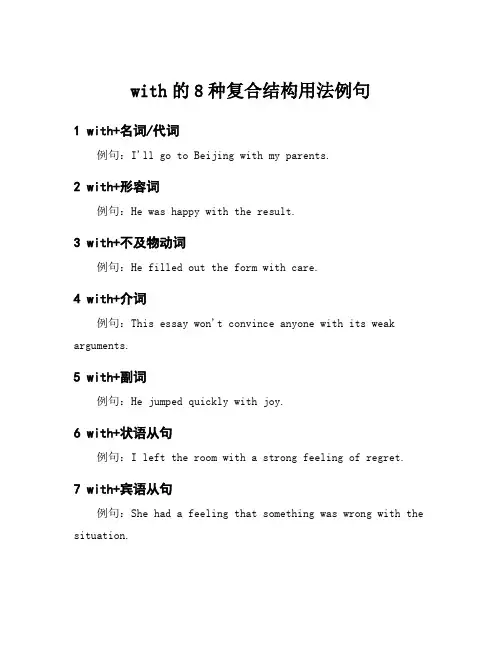
with的8种复合结构用法例句1 with+名词/代词例句:I'll go to Beijing with my parents.2 with+形容词例句:He was happy with the result.3 with+不及物动词例句:He filled out the form with care.4 with+介词例句:This essay won't convince anyone with its weak arguments.5 with+副词例句:He jumped quickly with joy.6 with+状语从句例句:I left the room with a strong feeling of regret.7 with+宾语从句例句:She had a feeling that something was wrong with the situation.8 with+状语动词例句:She played with enthusiasm.with复合结构十分常见,它和其他的复合结构有着很多共同特点,同时又有着其独特性。
with复合结构通常用来说明各部分之间的关系,可以用来提供状态、情感或变化等信息。
with复合结构可以用来表达任何我们心目中想象的东西。
with作为复合结构时,有以下8种结构用法:1 与名词或代词形成的复合结构,例如:I'll go toBeijing with my parents(我将与父母一起去北京);2 与形容词形成的复合结构,例如:He was happy with the result(他对结果很满意);3 与不及物动词形成的复合结构,例如:He filled out the form with care(他仔细填写了该表格);4 与介词形成的复合结构,例如:This essay won't convince anyone with its weak arguments(这篇文章因其弱小的论点而无法说服任何人);5 与副词形成的复合结构,例如:He jumped quickly with joy(他高兴地跳跃);6 与状语从句形成的复合结构,例如:I left the room with a strong feeling of regret(我强烈地后悔离开了房间);7 与宾语从句形成的复合结构,例如:She had a feeling that something was wrong with the situation(她有一种感觉,觉得情况不太对劲);8 与状语动词形成的复合结构,例如:She played with enthusiasm(她热情洋溢地玩耍)。
介词with的复合结构“with + 宾语+ 宾语补足语”构成介词with的复合结构,该结构在句中可作状语和定语。
在with复合结构中,宾语和宾补之间形成逻辑上的主谓关系。
当这种主谓关系表现为主动语态时,用现在分词;当这种主谓关系表现为被动语态时,用过去分词;当这种主谓关系表示将来意义时,用不定式;当这种主谓关系表示伴随意义时,用现在分词或副词。
常见的结构:1. with +宾语+介词短语1) He walked along the street with his hands in his pockets. (用作状语,宾补为介词短语)他手插衣袋沿街走着。
2) A girl stood at the door with an umbrella in her hands. (用作状语,宾补为介词短语)一位姑娘站在门口,手里拿着一把雨伞。
3) There were rows of white houses with trees in front of them. (用作定语,宾补为介词短语)这儿有一排排白色的房子,房前长着树木。
4) She saw a brook with red flowers and green grass on both sides. (用作定语,宾补为介词短语)她看到一条小溪,两岸长着红花绿草。
5) She left the office with tears in her eyes. (用作状语,宾补为介词短语)她眼里含着泪水,离开了办公室。
2. with +宾语+形容词1) Why did you sleep with the windows open? (用作状语,宾补为形容词)你为什么开着窗子睡觉?2) She sat down with her face pale with pain. (作状语,宾补为形容词)她坐下来,痛的脸色发白了。
3) He used to sleep with the door open. (宾补为形容词)他过去常开着门睡觉。
高中英语语法之With 的复合结构结构:with +名词./代词.+形容词/形容词短语/副词/介词短语/不定式/现在分词/过去分词.(1).with +名词./代词.+形容词/形容词短语With her father asleep , the daughter walked quietly out of the bedroom . 父亲睡着了,女儿悄悄地走出了卧室.It is considered to be bad manners to speak to others with your mouth full of food .满嘴食物和别人说话被认为是不礼貌的.(2).with +名词/代词+副词I’m used to working with the radio on .我习惯开着收音机工作.I stood there with my dog behind . 我站在那儿,我的狗在我后面.(3).with +名词/代词+介词短语With some beautiful flowers in her hands , she ran to the hero .她手捧鲜花向英跑去.They sat under the tree with their back to the wall .他们背对着墙坐在树下(4). with +名词/代词+不定式With the computer to do all the work , he had more free time .有计算机做所有的工作,他的空闲时间更多了.He was left alone , with no one to look after him .他被单独留下,无人照顾.(5). with +名词/代词+现在分词The teacher came in with some of his students following him . 老师走了近来,后面跟着几个他的学生.With the boy leading him the way , the old man had no trouble finding his o ld friend’s house .由于有小男孩给他引路,这位老人毫不费力地找到了他老朋友的家.(6). with +名词/代词+过去分词He had to walk to the school with his bike broken . 自行车坏了,他不得不步行上学.With her taken care of , we could go on with our work . 有人照顾她,我们可以继续工作了.2.句法功能:常在句中作状语(表伴随,原因,时间等)和后置定语.(1).在句中作状语The streets are more beautiful with all the lights on . 华灯齐放,大街更漂亮了. With time going on , Einstein’s theory proved to be correct . 随着岁月的流逝, 爱因斯坦的理论证明是正确的.(2).在句中作后置定语Any man with eyes in his head can see that he’s exactly like a rope .任何一个长眼睛的人都看到他正像一根绳子.The girl reached a river bank with so many flowers on both banks .小女孩来到一条两岸开满鲜花的河边.3.宾语补足语形式的选择:依据它和宾语之间的逻辑关系选择宾语补足语的形式.若为主表关系,选择形容词,副词和介词短语;若为主谓关系,选择现在分词(表示正在进行的动作);若为动宾关系,选择过去分词;选择不定式则表示将来的动作. (1).主表关系I once lived in a house with many trees and flowers around it .我曾住在一间鲜花和绿树环绕的房子里.The boy pulled on his shirt , with the wrong side out . 小男孩反穿着衬衫. He likes to sleep with the window open . 他喜欢开着窗户睡觉.(2).主谓关系The boy lay on the grass , with his eyes looking at the sky . 小男孩躺在草地上,两眼望着天空.With night coming on , we started for home . 夜幕来临,我们动身回家了. (3).动宾关系With nothing taken home , the girl was afraid to see her stepfather . 没有东西可带回家,小女孩不敢见继续父With so much work to do , we had to sit up throughout the night . 由于有许多工作要做,我们不得熬了个通宵.4.作状语时,with 的复合结构可以和独立主格互换The maths teacher walked into the classroom with a book in his hand .= The maths teacher walked into the classroom , book in hand . 数学老师手里拿着一本书走进教室.With the meeting over , they all left the hall in a great hurry . = The meetin g (being ) over , they all left the hall in a great hurry ..会议结束了,他们匆忙离开会议室.实战演练高考链接(用所给词的适当形式填空)1. News reports say peace talks between the two countries have broken down with no agreement _________ (reach).(2007NMET)2. _______ (介词) production up by 60%, the company has had another excell ent year.(NMET2000)3.The murderer was brought in, with his his hands _______(tie) behind his ba ck.(NMET2005)4. He lied on the chair , with a newspaper ________ (cover) his face. (NMET 2003)5. The sick old man was left alone under the tree, with his body ________ ( cover ) by a bag. (NMET1998)6.With nothing _______ (eat), the three children had to go hungry.7. With the fire ______, we saw nothing around us.用with翻译句子.1.He was taken to hospital, ____________________ ( 腿在流血bleed). 2.The fellow stood there, _____________________ (双手交叉cross在背后) 3.Don’t talk _________________(嘴里满满的)4. I told her the bad news, ______________ (心跳动beat地厉害).5. ______________ (嘴里含着一根勺子fork), the little girl cried.6._________________(电视机还开着), the old man fell asleep.答案:1.reached 2.With 3.tied 4.covering 5.covered 6. to eat 7.out1.with his leg bleeding2. with his hands crossed behind her back3. with your mouth full4.with her heart beating fast5. With a fork in her mouth6. With the TV on。
With 的复合宾语结构及分词的独立主格结构with 的复合宾语结构是高考的一个重点;分词的独立主格结构不是句子,因为没有实际的主语和谓语,该结构放在句首或句尾。
两者的语法功能和结构是相同的。
即两者在句中作状语,独立主格结构前加with 就构成了with的复合宾语结构。
㈠with 的复合宾语结构1.With+名词或代词+v-ingWith the crowds cheering, they drove to the palace. <伴随状语>=While____________________________________________________.With Peter working in Birmingham and Lucy travelling most of the week, the house seems pretty empty. <原因状语>=Because _________________________________________________.With time going on, our life is becoming more beautiful. <时间状语>= As______________________________________________________.※with后名词或代词与后面动词存在逻辑上主谓关系,即主动关系。
2. With+名词或代词+v-edWith the decision made, the next problem was how to make a good plan.=After ___________________________________________________.With the job finished, we went home straight away.=Because___________________________________________________.With more time given, I’ll explain this item in detail.=If _______________________________________________________.※with后名词或代词与后面动词存在逻辑上动宾关系,即被动关系。
with的复合结构with的复合结构在句中表状态或说明背景情况,常做伴随、方式、原因、条件等状语。
常见形式有七种,with+名词/代词+介词短语(形容词/副词/名词/done/-ing分词/to do)。
with复合结构的常见形式1.with+名词/代词+介词短语The man was walking on the street,with a book under his arm.那人在街上走着,腋下夹着一本书。
2.with+名词/代词+形容词With the weather so close and stuffy,ten to one it’ll rain presently.天气这么闷热,十之八九要下雨。
3.with+名词/代词+副词The square looks more beautiful than even with all the light on.所有的灯亮起来,广场看起来更美。
4.with+名词/代词+名词He left home,with his wife a hopeless soul.他走了,妻子十分伤心。
5.with+名词/代词+done(此结构过去分词和宾语是被动关系,表示动作已经完成。
)With this problem solved,neomycin 1 is now in regular production.随着这个问题的解决,新霉素一号现在已经正式产生。
6.with+名词/代词+-ing分词(此结构强调名词是-ing分词的动作的发出者或某动作、状态正在进行。
)He felt more uneasy with the whole class staring at him.全班同学看着他,他感到更不自然了。
7.with+宾语+to do(此结构中,不定式和宾语是被动关系,表示尚未发生的动作)So in the afternoon,with nothing to do,I went on a round of the bookshops.由于下午无事可做,我就去书店转了转。
深入理解带有with的复合结构在英语语法中,带有"with"的复合结构是一种常见的句式。
本文将深入探讨这一句式的用法及其语法特点。
1.带有"with"的复合结构的基本形式带有"with"的复合结构的基本形式为:"宾语 + with + 名词短语"。
该结构中的"宾语"可以是名词、代词、动名词或不定式,并且后面紧跟的名词短语通常是表示状态、条件或伴随情况的短语。
例如:带有"with"的复合结构的基本形式为:"宾语 + with + 名词短语"。
该结构中的"宾语"可以是名词、代词、动名词或不定式,并且后面紧跟的名词短语通常是表示状态、条件或伴随情况的短语。
例如:带有"with"的复合结构的基本形式为:"宾语 + with + 名词短语"。
该结构中的"宾语"可以是名词、代词、动名词或不定式,并且后面紧跟的名词短语通常是表示状态、条件或伴随情况的短语。
例如:带有"with"的复合结构的基本形式为:"宾语 + with + 名词短语"。
该结构中的"宾语"可以是名词、代词、动名词或不定式,并且后面紧跟的名词短语通常是表示状态、条件或伴随情况的短语。
例如:带有"with"的复合结构的基本形式为:"宾语 + with + 名词短语"。
该结构中的"宾语"可以是名词、代词、动名词或不定式,并且后面紧跟的名词短语通常是表示状态、条件或伴随情况的短语。
例如:带有"with"的复合结构的基本形式为:"宾语 + with + 名词短语"。
该结构中的"宾语"可以是名词、代词、动名词或不定式,并且后面紧跟的名词短语通常是表示状态、条件或伴随情况的短语。
with的七种复合结构用法一、with+复合宾语。
这种结构表示“用某物做某事”,with后跟表示“手段”或“方法” (如:words,tools,hands,a knife,a hammer,tissues,mathematics,a pen,a pencil)的名词或动词不定式。
例如:He repaired the chair with a hammer. 他用锤子修理了椅子。
My daughter has done her homework with a pen. 我的女儿用钢笔做家庭作业。
二、with+复合主语。
这种结构表示“把某人和某人或某事联系在一起”,with后跟人或事物名词,也可以跟代词。
例如:My brother lives with his grandmother. 我兄弟和他的奶奶住在一起。
I am very familiar with the city. 我对这个城市很熟悉。
三、with+复合状语。
这种结构表示“带着某物”或“伴随着某事”,with后跟表示“手段”或“方法”(如:courage,honors,tears,patience,applause,a smile)的名词或动词不定式。
例如:He arrived with a smile. 他带着微笑到达。
She graduated with honors. 她以优异成绩毕业。
四、with+复合表语。
这种结构表示“和……一起”,with后跟名词、代词、形容词或动词不定式。
例如:The house is furnished with modern furniture. 这个房子里有现代家具。
The room is filled with sunshine. 这个房间里充满阳光。
五、with+复合宾语从句。
这种结构表示“做某事时考虑某事”,with后有从句,这个从句有时是否定的。
例如:He dealt with the problem with much patience. 他耐心地处理这个问题。
基本用法
它是由介词with或without+复合结构构成,复合结构作介词with或without的复合宾语,复合宾语中第一部分宾语由名词或代词充当,第二部分补足语由形容词、副词、介词短语或非谓语动词充当
一、with或without+名词/代词+形容词
例句:1.I like to sleep with the windows open.
我喜欢把窗户开着睡觉。
(伴随情况)
2.With the weather so close and stuffy, ten to one it'll rain presently.
大气这样闷,十之八九要下雨(原因状语)
二、with或without+名词/代词+副词
例句:1.She left the room with all the lights on.
她离开了房间,灯还亮着。
(伴随情况)
2.The boy stood there with his head down.
这个男孩低头站在那儿。
(伴随情况)
三、with或without+名词/代词+介词短语
例句:1.He walked into the dark street with a stick in his hand.
他走进黑暗的街道时手里拿着根棍子。
(伴随情况)
2. With the children at school, we can't take our vacation when we want to.
由于孩子们在上学,所以当我们想度假时而不能去度假。
(原因状语)
四、with或without+名词/代词+非谓语动词
1、with或without+名词/代词+动词不定式,此时,不定式表示将发生的动作。
例句: 1.With no one to talk to, John felt miserable.
由于没人可以说话的人,约翰感到很悲哀。
(原因状语)
2. With a lot of work to do, he wasn't allowed to go out.
因为还有很多工作要做,他没有被允许外出。
(原因状语)
2、with + 名词(或代词) + 现在分词,此时,现在分词和前面的名词或代词是逻辑上的主谓关系。
例句: 1.With prices going up so fast, we can't afford luxuries.
由于物价上涨很快,我们买不起高档商品。
(原因状语)
2. With the crowds cheering, they drove to the palace.
在人群的欢呼声中,他们驱车来到皇宫。
(伴随情况)
3、with + 名词(或代词) + 过去分词,此时,过去分词和前面的名词或代词是逻辑上的动宾关系。
例句: 1.I sat in my room for a few minutes with my eyes fixed on the ceiling.
我在房间坐了一会儿,眼睛盯着天花板。
(伴随情况)
2.She had to walk home with her bike stolen. 自行车被偷,她只好步行回家。
(原因状语)
五、with或without+名词/代词+补语
例句:1.Possibly this person died without anyone knowing where the coins were hidden.
有可能,这个人死的时候还没有人知道那些钱币被藏在哪里。
2.He wondered if he could slide out of the lecture hall without anyone noticing (him).
他想他是否可以在没有人注意到他的情况下悄悄溜出演讲大厅
3、with the winter coming
随着冬天的来临
※with+不定式和+分词的区别:
加不定式是指将要进行的动作,加分词是指主动或被动动作.
六、with +宾语(名词,代词)+名词
例句:1.He died with his daughter a schoolgirl
他在他女儿是个小学生的时候死了
句法功能
一、with 复合结构,在句中表状态或说明背景情况该结构常做伴随、方式、原因、条件等状语。
例句:1、With machinery to do all the work, they will soon have got in the crops.
由于所有的工作都是由机器进行,他们将很快收完庄稼。
(原因状语)
2、The boy always sleeps with his head on the arm.
这个孩子总是头枕着胳膊睡觉。
(伴随状语)
3、The soldier had him stand with his back to his father.
士兵要他背对着他父亲站着。
(方式状语)
4、With spring coming on, trees turn green.
春天到了,树变绿了。
(时间状语)
二、with 复合结构可以作定语
例句:Anyone with its eyes in his head can see it's exactly like a rope.
任何一个头上长着眼睛的人都能看出它完全像一条绳子。
三、like+名词/代词+补语
例句:1、The old pinetree still stood there like an umbrella covering the entrance of the cave.
这颗老松树依然耸立在那,像伞一样盖住了洞穴
2、The noise sounded like a train going under my house.
这声音听起来像是一列火车在我的屋子下面经过一样。